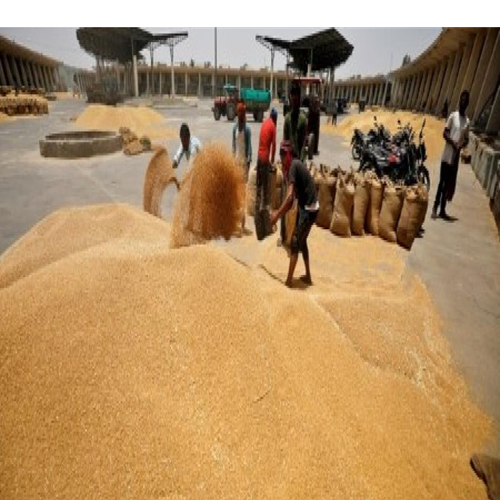Sluggish wheat purchases in some states may hinder achievement of Centre’s procurement target

Wheat procurement faces challenges due to weather delays and better open market prices. Government targets 37 mt but anticipates 26 mt, with 19.9 mt in the central pool. Rajasthan and UP fall below targets. Action plan includes pre-registration and timely payments. Wheat production estimated at 112 mt by the government and 105.7 mt by a survey.
A delay in wheat harvest by 10–15 days, remunerative prices in the open market, and poor machinery of state procuring agencies may hit the Centre’s wheat procurement in the ongoing rabi season, a top official said.
This, despite the pace of procurement picking up in recent weeks, with the deficit shrinking to 3% as of 6 May from 25% almost a fortnight ago. As of Monday, the government could procure about 23.8 mt in the 2024-25 rabi season against 24.5 mt during the corresponding period last year.
The rabi season runs from October to March, and procurement happens from April to May. However, this time, the Centre decided to allow states to procure depending on the arrival of the crop in the market. In most states, wheat arrivals begin in the first fortnight of March.
The target and status
India has targeted to procure around 37 million tonnes of wheat this season, according to data from Food Corporation of India (FCI). However, food and public distribution secretary Sanjeev Chopra sees it to be 31 mt, while he was hopeful that the government would meet this target, he added, “Taking the worst-case scenario, wheat procurement could be 26 mt, which we did last year. This would be sufficient to meet the NFSA (National Food Security Act) requirement of 18-20 mt and market interventions of 14 mt. We had an opening balance of 8 mt.”
About 19.9 mt wheat is currently available in the central pool against the buffer norm of 7.46 mt as of 1 April.
The 2023-24 rabi season saw the government procuring 26.2 mt of wheat against a target of 34.15 mt. The previous season, it had procured 18.8 mt against a target of 44.4 mt. If the target is missed this year, it would be for the third year in succession. About 19.9 mt wheat is currently available in the central pool against the buffer norm of 7.46 mt as of 1 April.
What’s holding up procurement
“There was unseasonal rainfall in Punjab, Haryana and parts of Rajasthan. As a result, moisture content in wheat went high. Therefore, farmers were advised to let the crop mature and not harvest it. Harvest it once the weather improves. Harvesting is delayed by 10-15 days in these states,” Chopra told Mint. “Higher price offerings by private traders in some states like MP (Madhya Pradesh), Rajasthan and Bihar are another reason. We do not resent farmers getting better prices. It is good for farmers to get remunerative prices in the open market.””The wheat stock with FCI falling to the buffer level this year has not impacted the supply side as OMSS (open market sale scheme) distribution was not needed after February. Besides, the stock is not so low as to adversely impact the distribution under welfare schemes,” said G.K. Sood, a farm expert. “Target is not important. What is important is whether the quantity procured will meet the demand for FCI stocks going forward. This year’s crop being about 5 million tonnes higher, with procurement being at the same level as the past year, the pipeline stocks are expected to have improved. There lies the comfort.””The wheat stock with FCI falling to the buffer level this year has not impacted the supply side as OMSS (open market sale scheme) distribution was not needed after February. Besides, the stock is not so low as to adversely impact the distribution under welfare schemes,” said G.K. Sood, a farm expert. “Target is not important. What is important is whether the quantity procured will meet the demand for FCI stocks going forward. This year’s crop being about 5 million tonnes higher, with procurement being at the same level as the past year, the pipeline stocks are expected to have improved. There lies the comfort.”
Below target
A senior official with the FCI told Mint earlier that wheat procurement in the current season in Rajasthan could be around 1.5 mt against the target of 2 mt, and 2 mt from Uttar Pradesh against the target of 6 mt. Procurement in Madhya Pradesh, Punjab, Haryana and Bihar may not be less than 8 mt, 13 mt, 7 mt and 2 mt, respectively, on par with their targets.
Wheat purchase has so far been 710,718 tonnes in Uttar Pradesh against the previous year’s 151,857 tonnes. The government could purchase 612,304 tonnes from Rajasthan compared to last season’s 224,205 tonnes and 8,278 tonnes from Bihar against 379 tonnes in the previous year. Last year, total procurement in the rabi season was a low 220,000 tonnes in UP, 438,000 in Rajasthan and 1,000 tonnes in Bihar.
Action plan on
The higher procurement in the current season in these states is due to low purchase in the previous season, driving the government to prepare an action plan that includes pre-registration of farmers, timely payments and campaign to create awareness.“Procurement in UP (Uttar Pradesh) is progressing; it is better than the previous year. However, there is scope for improvement,” said Chopra, adding that in the case of Bihar, procurement centres were not equipped. “They said farmers are going to private traders because they are getting money in cash at spot. I am doubtful whether we will have the kind of performance we expected in Bihar. Additionally, this year we are trying to make payments to farmers within 48 hours. I’d say it is happening in 70-80% of cases. In the remaining cases, it is not happening for various reasons.”Wheat production in India, the world’s second-largest wheat producer and consumer after China, is estimated to be marginally higher on-year at 112 mt (as per the government), and lower at 105.7 mt (according to a survey of the standing crop, conducted by the Roller Flour Millers’ Federation of India and Agriwatch)
















